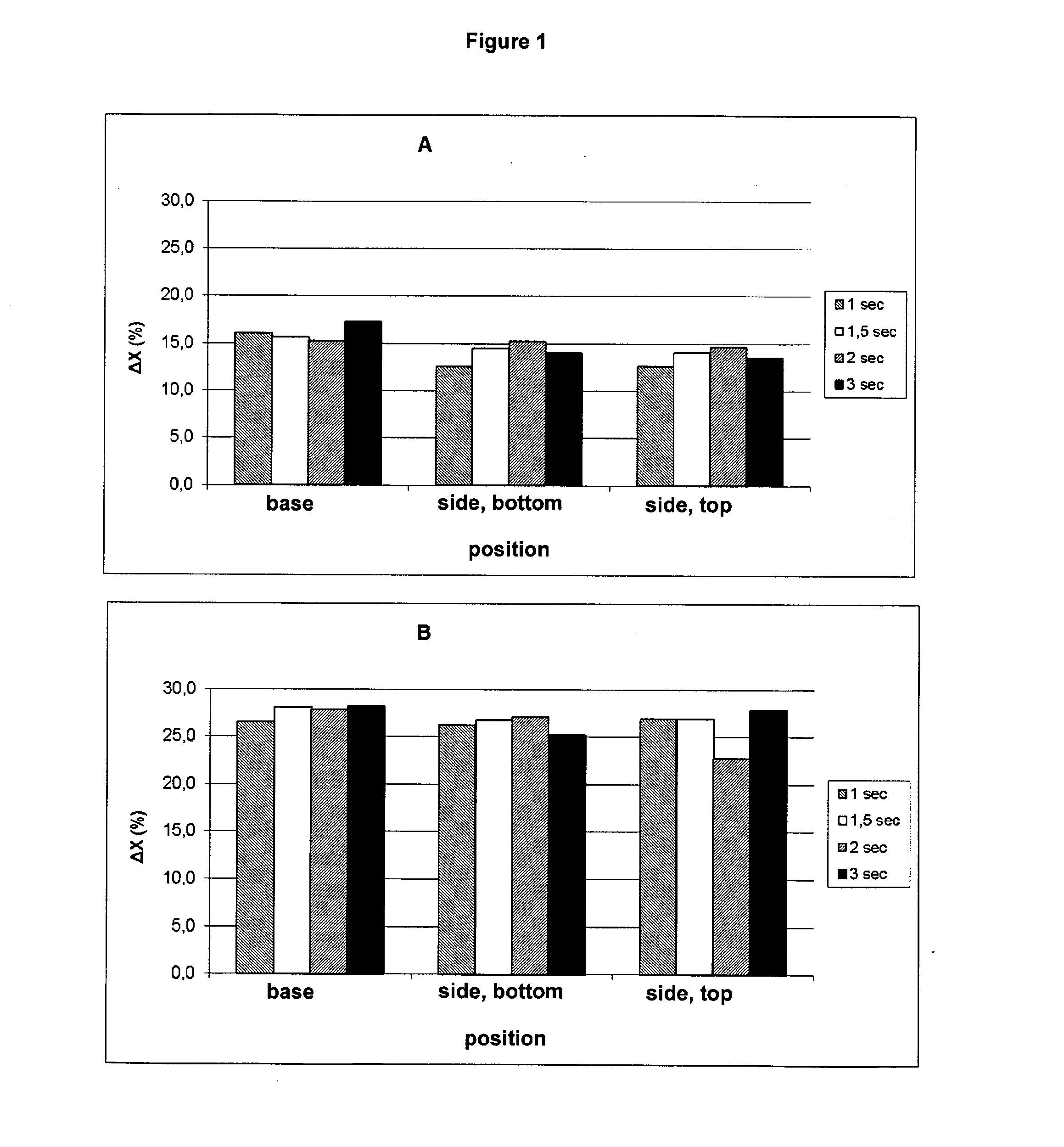Compound comprising plla and pdla
- Summary
- Abstract
- Description
- Claims
- Application Information
AI Technical Summary
Benefits of technology
Problems solved by technology
Method used
Image
Examples
example 3
[0046]The following example shows that PDLA can also increase the crystallisation rate in PLLA. As PLLA is optically pure, the crystallisation rate in combination with PDLA is substantially higher than in the previous example. Better HDT-B values were obtained after crystallisation. And again better mechanical properties were observed.
TABLE 3PLLA & PDLAComponent / Property123Synterra ® PLLA 1510 (Synbra)80——Synterra ® PLLA 1010 (Synbra)—8080Synterra ® PDLA 0710 (Synbra)55—Synterra ® PDLA 1010 (Synbra)——5DOA (Sigma)555Talc (Luzenac A10X C)101010HDT-B (° C.)123122123Modulus of elasticity (MPa)414438753453Tensile strength (MPa)48.347.847.7Elongation at break (%)14.07.89.9Charpy impact, unnotched (kJ / m2)>86.860.8>88.6Charpy impact, notched (kJ / m2)3.12.64.6
example 4
[0047]The following example shows that the cycle time during injection-moulding can be reduced by using a mixture of PLLA and PDLA according to the present invention. Very short cycle times are obtained when extra talc and plasticiser are used. The molecular weight of the PDLA largely determines the crystallisation rate, and hence the cycle time. It was found to be possible to reduce the cycle time by lowering the molecular weight of the PDLA. Synterra® PLLA 1098 and Synterra® PDLA 1098 have an optical purity of less than 95%. It was possible to carry out the injection-moulding process fully automatically on the basis of formulations 3, 4 and 5, with a surprisingly short cycle time for these compounds.
TABLE 4Injection-moulding tests (*comparative example)Component / Property123456*78Synterra ® PLLA 10109595808080100—80(Synbra)Synterra ® PLLA 1098——————80—Synterra ® PDLA 07105—52.5————(Synbra)Synterra ® PDLA 1010—5—2.55—5—(Synbra)Synterra ® PDLA 1098———————5DOA (Sigma)——555—55Talc (Luz...
example 5
[0048]Flowerpots were made by means of thermoforming using a formulation similar to that in the previous example. It was noted that the pressure in the extruder increased during the production of the sheet, after PDLA had been added to PLLA. This is an indication of improved melt strength. It proved to be possible to produce a sheet that is suitable for thermoforming using a formulation consisting of 65 parts by weight of Synterra® PLLA 2010, 5 parts by weight of Synterra® PDLA 1510 and 30 parts by weight of chalk. The thermoforming was carried out using both a cold and a hot (110° C.) mould.
[0049]The crystallinity and crystallisation rate of PLA can be determined by means of Differential Scanning Calorimetry (DSC). In a DSC diagram, amorphous PLA will show only a glass transition point, at about 55° C., whereas semi-crystalline PLA will also show a crystallisation and / or melt peak. The size of the melt peak (Δx) is a measure of the extent to which crystallisation has taken place. T...
PUM
| Property | Measurement | Unit |
|---|---|---|
| Temperature | aaaaa | aaaaa |
| Fraction | aaaaa | aaaaa |
| Fraction | aaaaa | aaaaa |
Abstract
Description
Claims
Application Information
 Login to View More
Login to View More - R&D
- Intellectual Property
- Life Sciences
- Materials
- Tech Scout
- Unparalleled Data Quality
- Higher Quality Content
- 60% Fewer Hallucinations
Browse by: Latest US Patents, China's latest patents, Technical Efficacy Thesaurus, Application Domain, Technology Topic, Popular Technical Reports.
© 2025 PatSnap. All rights reserved.Legal|Privacy policy|Modern Slavery Act Transparency Statement|Sitemap|About US| Contact US: help@patsnap.com

